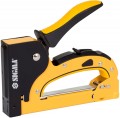Product type
General purpose of the instrument.
A construction stapler in the original sense of the word is called a staple gun — a tool designed to work exclusively with staples. For driving nails, in turn,
nailers are used, while in such devices the matter may not be limited to nails alone. However, the most versatile are the combined models —
2-in-1 and
3-in-1 staplers. Here is a more detailed description of all these varieties:
— Stapler. Stapling tools that are not intended for use with other types of fasteners. One of the most popular areas of application for such devices is furniture production and other activities where it is necessary to sheathe various structures with fabric, mesh, etc.; although, of course, the matter is not limited to this. Anyway, staplers are not as versatile as 2-in-1 and 3-in-1 models, but at the same cost, a highly specialized tool usually turns out to be more performant, practical and reliable than a combination device.
— Nayler. He's also a "nail gun". Tools similar to staplers, but designed to work with nails (sometimes also with pins / studs) and do not involve the use of staples. For a number of reasons, pneumatic nailers are most widely used nowadays, but there are other variations.
— Stapler (2-in-1). Devices that can work with both staples and nails; in other words, a combination of a traditional stapler and
...a nailer in one tool. The main advantage of such models is versatility: a combined tool can replace two specialized ones at once. At the same time, it will cost significantly less than two separate devices, and it will take up less space; and to switch between different types of fasteners in many models, you don’t even need to change the store — just load the desired type of consumables into it. However, if you plan to work with only one type of fastener, you should not buy a combined device so as not to overpay for unnecessary functionality.
— Stapler (3 in 1). Tools from this category are capable of working with staples and nails, as well as with pins (studs). Thus, such models are generally similar to 2 in 1 devices, but they have even more extensive functionality and, accordingly, are somewhat more expensive.Fastener type
—
Nail. Traditional nails are pointed rods with hats. However, hammers are often made for specific types of nails, and ordinary ones cannot be charged in them, this point in each case must be clarified separately. The nail is usually hammered in as a whole, right up to the head; such fasteners are tightly held in the material.
—
Staple. Colloquially, staples are sometimes referred to as "paper clips", although this is not entirely true. Such fasteners are familiar to many from ordinary stationery staplers, however, staples can also be used for more serious tasks — for example, attaching upholstery to wooden furniture. They do not hold as tightly as nails, but the oblong shape of the staple is in some cases a decisive advantage, and reliability is often enough.
—
Pin / hairpin. Fasteners that are driven in the same way as nails, but do not have expanded hats at the top. In addition, they differ somewhat in application: the pin can protrude above the surface of the material, or vice versa, be completely hidden inside, in such a way that then “mask” the fasteners with putty, decorative film, etc. All this requires specific design features, so not every stapler capable of using nails will be compatible with pins / studs.
Resource
The number of "shots" for which the impact mechanism of the construction stapler is designed. For models with a twisted spring, it averages 10 – 12K strokes, for instances with a leaf spring — 55 – 60K operations.
Min. staple length
The smallest length of staples (see Fastener Type) that the stapler can work with.
The length in this case means the length of the leg — in other words, the depth to which the staple clogged "to the stop" penetrates into the material. Small staples do not require much power to drive, but the tool may not be designed for fasteners that are too short due to other parameters — for example, the design of the magazine. Therefore, for many models, this limitation is quite relevant, and in powerful professional models, the minimum length can be quite large — more than 20 mm.
Max. nail length
The longest length of nails (see Fastener Type) that the stapler can handle.
With the same thickness, a longer nail requires not only the appropriate space in the magazine and feed mechanism, but also a higher impact energy — otherwise it simply will not work to hammer it “on the head”. This means that the maximum fastener length is directly related to the power and, accordingly, the overall level of the tool. Recall that a powerful professional tool has the appropriate dimensions and weight, moreover, it is often made pneumatic (for more details, see "Type"). Therefore, it makes sense to look for models that are compatible with long nails only if this is critical for the planned work.
Max. pin length
The longest attachment pin (see Attachment Type) that the stapler can handle.
A long pin not only needs to fit in the magazine and the feed mechanism of the tool — it also requires significant effort to be applied, otherwise the part cannot be hammered to the desired depth. Accordingly, an increase in the permissible length of the pin (with the same thickness) requires an increase in the power of the tool, and this, in turn, affects the dimensions, weight and price. In fact, this means that the principle "the more — the better" does not work in this case — you should choose a stapler based on how much longer the length is really needed for the planned work.

